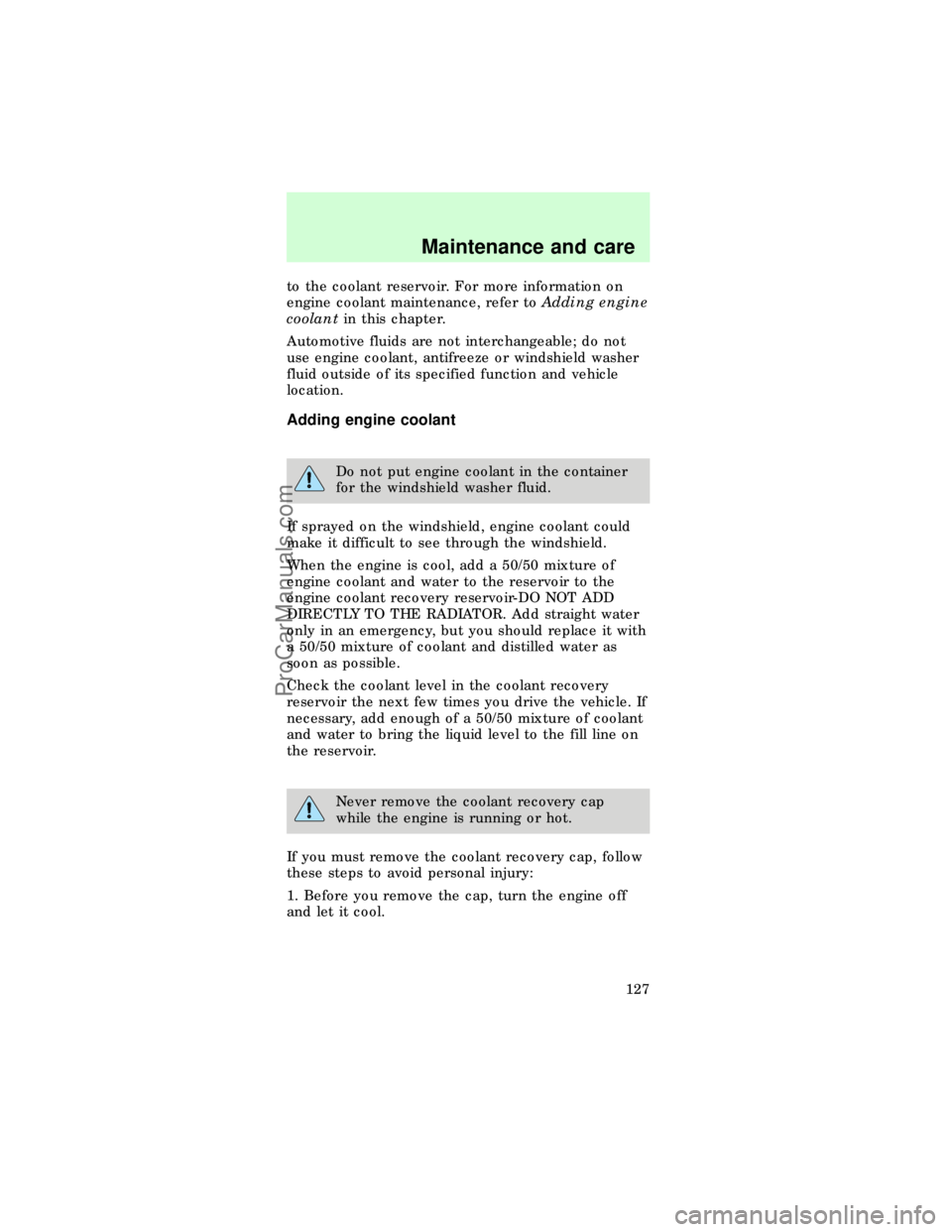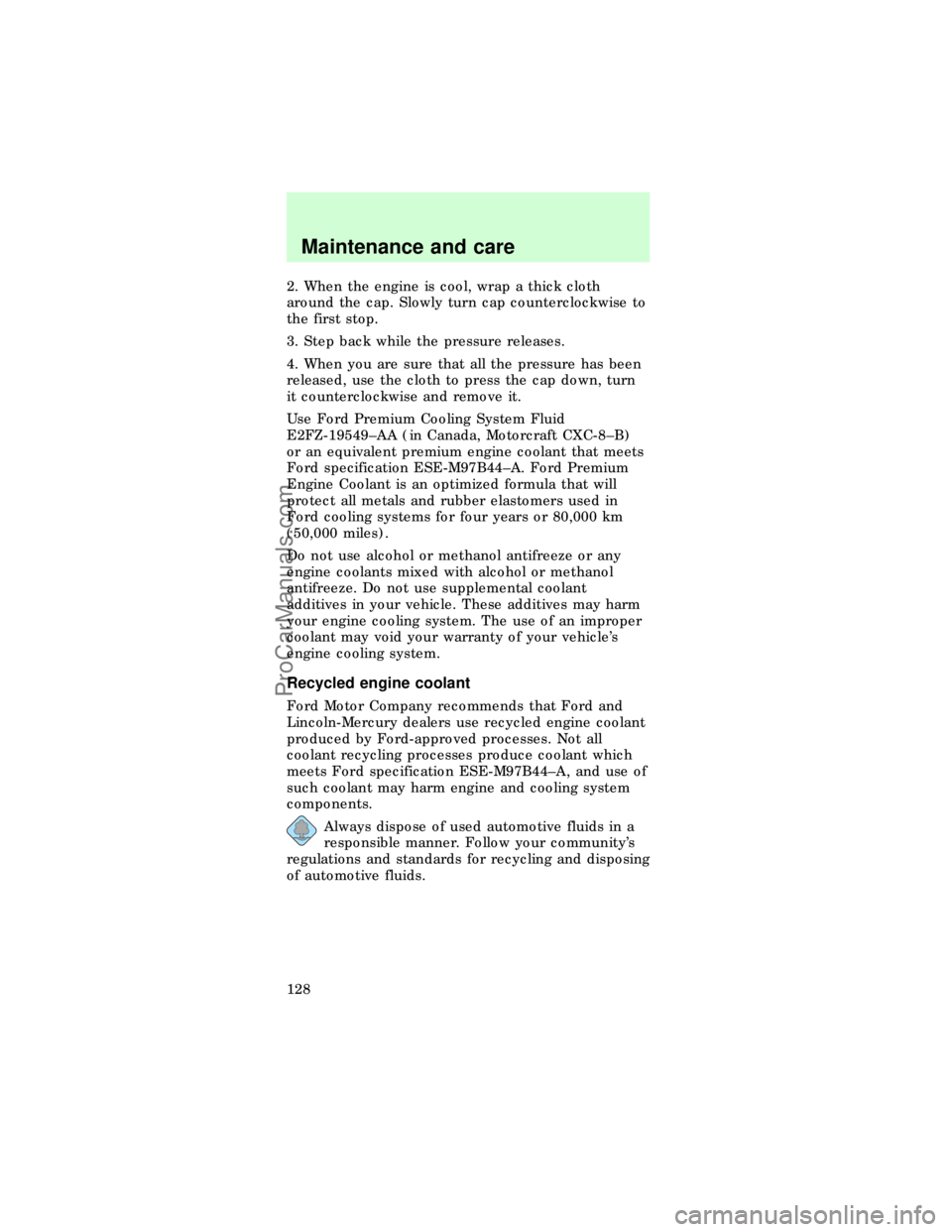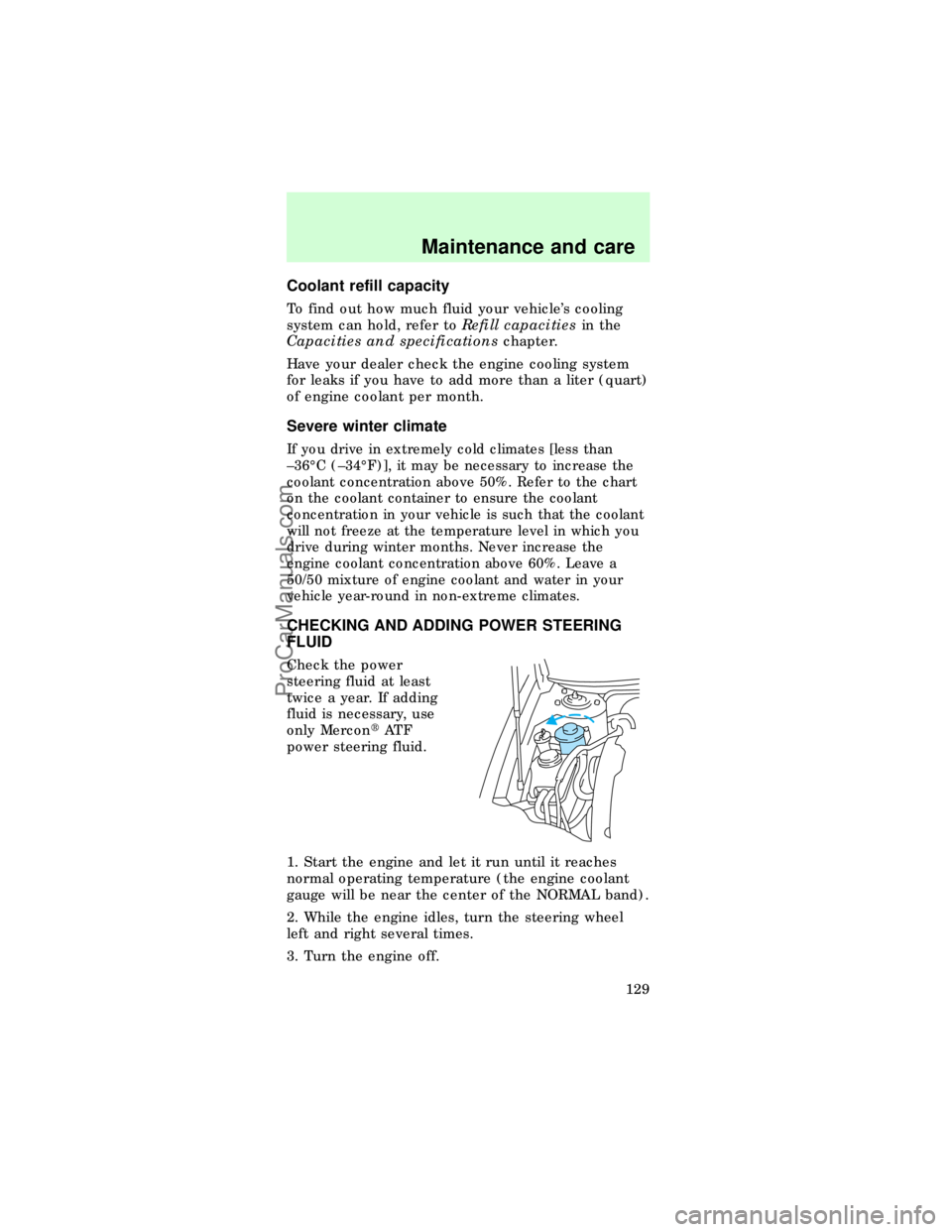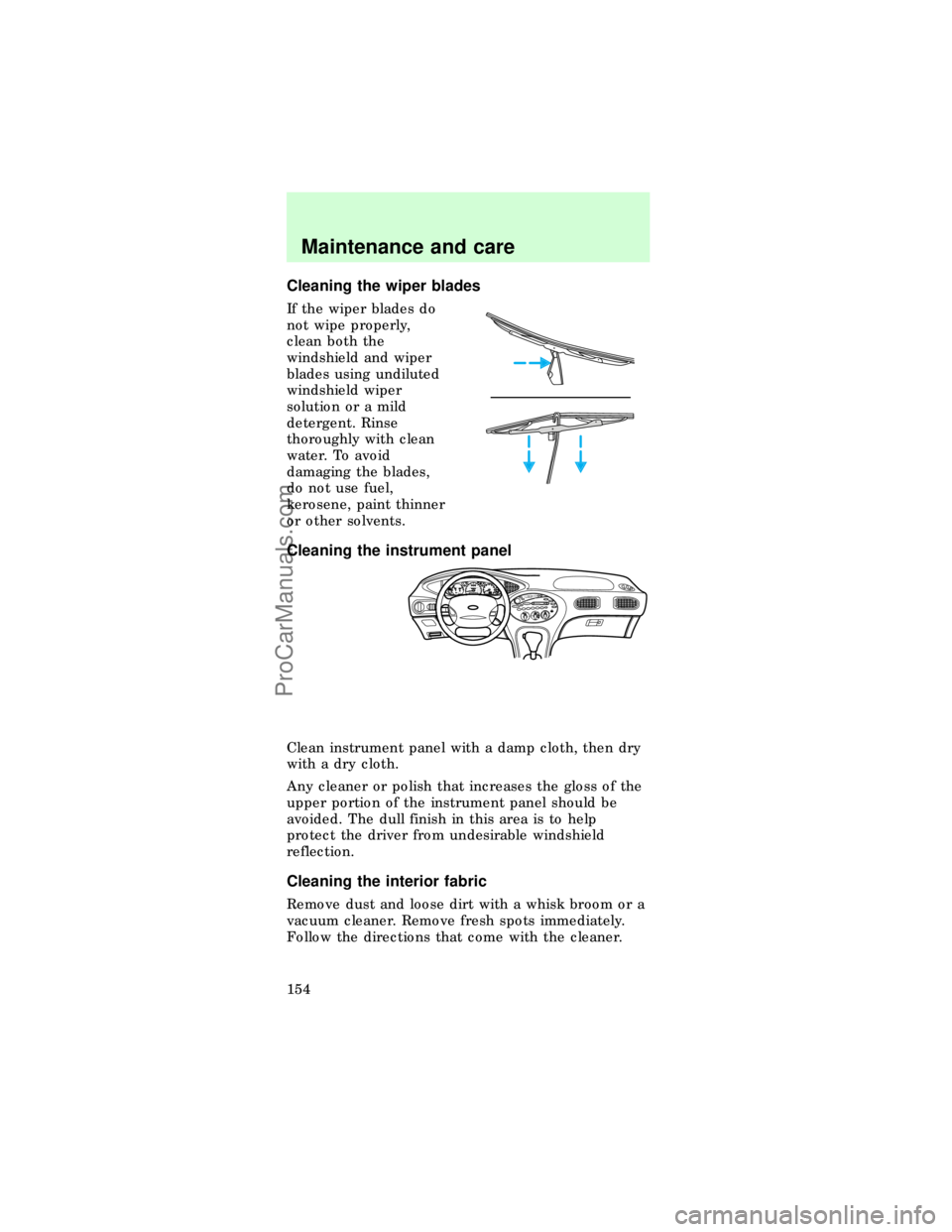Page 120 of 167
1. Automatic transaxle fluid dipstick
2. Brake fluid reservoir
3. Air filter assembly
4. Battery
5. Engine oil filler cap
6. Engine oil dipstick
7. Power steering fluid reservoir
8. Engine coolant reservoir
9. Windshield washer fluid reservoir
3.0L Duratec engine
1. Automatic transaxle fluid dipstick
2. Brake fluid reservoir
3. Air filter assembly
4. Battery
5. Engine oil filler cap
6. Engine oil dipstick
7. Engine coolant reservoir
8912
3
4
56
7
Maintenance and care
121
ProCarManuals.com
Page 121 of 167
8. Windshield washer fluid reservoir
9. Power steering fluid reservoir
3.4L SHO engine
1. Automatic transaxle fluid dipstick
2. Brake fluid reservoir
3. Air filter assembly
4. Battery
5. Engine oil dipstick
6. Engine oil filler cap
7. Engine coolant reservoir
8. Windshield washer fluid reservoir
9. Power steering fluid reservoir
8
9123
456
7
Maintenance and care
122
ProCarManuals.com
Page 125 of 167
CHECKING AND ADDING WASHER FLUID
Check the washer fluid
whenever you stop for
fuel. The reservoir is
highlighted with a
washer symbol.
If the level is low, add enough fluid to fill the
reservoir. In very cold weather, do not fill the
reservoir all the way.
Checking and adding washer fluid for the
liftgate (wagon only)
The opening for the reservoir is located on the
passenger side under the tail lamp. Refill this
reservoir with the same fluid you use for your
windshield.
CHECKING AND ADDING ENGINE COOLANT
Check the level of the
coolant in the reservoir
at least once a month.
Be sure to read and
understand
Precautions when
servicing your vehicle
in this chapter.
If the engine coolant has not been checked for a
long period of time, the engine coolant reservoir may
eventually empty. If this occurs, add engine coolant
Maintenance and care
126
ProCarManuals.com
Page 126 of 167

to the coolant reservoir. For more information on
engine coolant maintenance, refer toAdding engine
coolantin this chapter.
Automotive fluids are not interchangeable; do not
use engine coolant, antifreeze or windshield washer
fluid outside of its specified function and vehicle
location.
Adding engine coolant
Do not put engine coolant in the container
for the windshield washer fluid.
If sprayed on the windshield, engine coolant could
make it difficult to see through the windshield.
When the engine is cool, add a 50/50 mixture of
engine coolant and water to the reservoir to the
engine coolant recovery reservoir-DO NOT ADD
DIRECTLY TO THE RADIATOR. Add straight water
only in an emergency, but you should replace it with
a 50/50 mixture of coolant and distilled water as
soon as possible.
Check the coolant level in the coolant recovery
reservoir the next few times you drive the vehicle. If
necessary, add enough of a 50/50 mixture of coolant
and water to bring the liquid level to the fill line on
the reservoir.
Never remove the coolant recovery cap
while the engine is running or hot.
If you must remove the coolant recovery cap, follow
these steps to avoid personal injury:
1. Before you remove the cap, turn the engine off
and let it cool.
Maintenance and care
127
ProCarManuals.com
Page 127 of 167

2. When the engine is cool, wrap a thick cloth
around the cap. Slowly turn cap counterclockwise to
the first stop.
3. Step back while the pressure releases.
4. When you are sure that all the pressure has been
released, use the cloth to press the cap down, turn
it counterclockwise and remove it.
Use Ford Premium Cooling System Fluid
E2FZ-19549±AA (in Canada, Motorcraft CXC-8±B)
or an equivalent premium engine coolant that meets
Ford specification ESE-M97B44±A. Ford Premium
Engine Coolant is an optimized formula that will
protect all metals and rubber elastomers used in
Ford cooling systems for four years or 80,000 km
(50,000 miles).
Do not use alcohol or methanol antifreeze or any
engine coolants mixed with alcohol or methanol
antifreeze. Do not use supplemental coolant
additives in your vehicle. These additives may harm
your engine cooling system. The use of an improper
coolant may void your warranty of your vehicle's
engine cooling system.
Recycled engine coolant
Ford Motor Company recommends that Ford and
Lincoln-Mercury dealers use recycled engine coolant
produced by Ford-approved processes. Not all
coolant recycling processes produce coolant which
meets Ford specification ESE-M97B44±A, and use of
such coolant may harm engine and cooling system
components.
Always dispose of used automotive fluids in a
responsible manner. Follow your community's
regulations and standards for recycling and disposing
of automotive fluids.
Maintenance and care
128
ProCarManuals.com
Page 128 of 167

Coolant refill capacity
To find out how much fluid your vehicle's cooling
system can hold, refer toRefill capacitiesin the
Capacities and specificationschapter.
Have your dealer check the engine cooling system
for leaks if you have to add more than a liter (quart)
of engine coolant per month.
Severe winter climate
If you drive in extremely cold climates [less than
±36ÉC (±34ÉF)], it may be necessary to increase the
coolant concentration above 50%. Refer to the chart
on the coolant container to ensure the coolant
concentration in your vehicle is such that the coolant
will not freeze at the temperature level in which you
drive during winter months. Never increase the
engine coolant concentration above 60%. Leave a
50/50 mixture of engine coolant and water in your
vehicle year-round in non-extreme climates.
CHECKING AND ADDING POWER STEERING
FLUID
Check the power
steering fluid at least
twice a year. If adding
fluid is necessary, use
only MercontAT F
power steering fluid.
1. Start the engine and let it run until it reaches
normal operating temperature (the engine coolant
gauge will be near the center of the NORMAL band).
2. While the engine idles, turn the steering wheel
left and right several times.
3. Turn the engine off.
Maintenance and care
129
ProCarManuals.com
Page 153 of 167

Cleaning the wiper blades
If the wiper blades do
not wipe properly,
clean both the
windshield and wiper
blades using undiluted
windshield wiper
solution or a mild
detergent. Rinse
thoroughly with clean
water. To avoid
damaging the blades,
do not use fuel,
kerosene, paint thinner
or other solvents.
Cleaning the instrument panel
Clean instrument panel with a damp cloth, then dry
with a dry cloth.
Any cleaner or polish that increases the gloss of the
upper portion of the instrument panel should be
avoided. The dull finish in this area is to help
protect the driver from undesirable windshield
reflection.
Cleaning the interior fabric
Remove dust and loose dirt with a whisk broom or a
vacuum cleaner. Remove fresh spots immediately.
Follow the directions that come with the cleaner.
BASSTREBBALFADEREWFFEJECT1234
56wTAPE SIDETAPE
R-DEFTUNESEEKSCAN AM
FMMH
LO
HIOFF
A/C
MAX
A/CVENTVOL
PUSH-ONwSTFM 12
AMCBLRFEFC HFUEL DOOR>SERVICE
ENGINE
SOONLOW
COOLANTTHEFT102030405060
70
80
90
100
1202060100
140
180P R N D 2 1MPH km/h0000000000P!
BRAKE+ –110CRUISERPMx1000ABSO/D
OFFREAR
LAMP
OUTPREMIUM UNLEADED
FUEL RECOMMENDED0 1234
5
6
78
Maintenance and care
154
ProCarManuals.com
Page 156 of 167
Component Part number
Passenger
compartment air filter
(if equipped)FP-6
Oil filter FL-820-S
PCV valve EV-152
Spark plug AWSF-32F
3.4L SHO engine
Component Part number
Air filter FA-1630
Battery BXT-36R
Fuel filter FG-800-A
Passenger
compartment air filter
(if equipped)FA1628
Oil filter FL-400A
PCV valve EV-234
Spark plug AWSF-32FM
REFILL CAPACITIES
3.0L Vulcan engine
Fluid Ford Part
NameVehicle
TypeCapacity
Brake
fluidHigh
performance
DOT 3
brake fluidAll Fill to line
in reservoir
Engine
coolantPremium
cooling
system fluidAll 11.0 (11.6)
Capacities and specifications
157
ProCarManuals.com